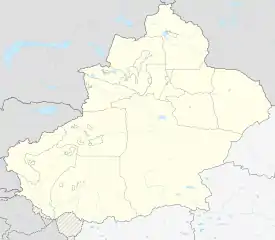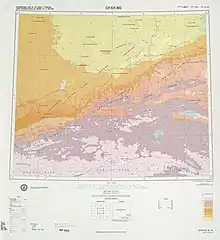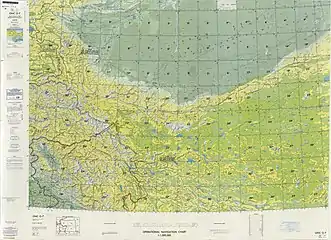Ruoqiang County
Ruoqiang County (Chinese: 若羌县) as the official romanized name, also transliterated from Uyghur as Qakilik County[3] (Uighur: چاقىلىق ناھىيىسى; Chinese: 卡克里克县), is a county in the Xinjiang Uyghur Autonomous Region, China under the administration of the Bayingolin Mongol Autonomous Prefecture. It covers an area of 198,318 square kilometres (76,571 sq mi) (about twice the size of Zhejiang province and similar to Kyrgyzstan or Senegal),[4] making it the largest county-level division in the country.[5]
Ruoqiang County
若羌县 • چاقىلىق ناھىيىسى Qakilik, Charkhlik, Chochiang | |
|---|---|
 | |
.png.webp) Ruoqiang County (red) within Bayingolin Prefecture (yellow) and Xinjiang | |
 Ruoqiang Location of the seat in Xinjiang | |
| Coordinates (County government): 39°01′23″N 88°10′01″E | |
| Country | People's Republic of China |
| Region | Xinjiang |
| Autonomous prefecture | Bayingolin |
| County seat | Ruoqiang Town |
| Area | |
| • Total | 199,222 km2 (76,920 sq mi) |
| Elevation | 896 m (2,940 ft) |
| Population (2010)[1] | |
| • Total | 35,580 |
| • Density | 0.18/km2 (0.46/sq mi) |
| Ethnic groups | |
| • Major ethnic groups | Han Chinese, Uyghur[2] |
| Time zone | UTC+8 (China Standard) |
| Postal code | 841800 |
| Area code(s) | 0966 |
| Website | loulan |
| Ruoqiang County | |||||||||||
|---|---|---|---|---|---|---|---|---|---|---|---|
| Chinese name | |||||||||||
| Simplified Chinese | 若羌县 | ||||||||||
| Traditional Chinese | 婼羌縣 | ||||||||||
| |||||||||||
| Alternative Chinese name | |||||||||||
| Simplified Chinese | 卡克里克县 | ||||||||||
| Traditional Chinese | 喀格勒克縣 | ||||||||||
| |||||||||||
| Uyghur name | |||||||||||
| Uyghur | چاقىلىق ناھىيىسى | ||||||||||
| Literal meaning | Charklik | ||||||||||
| |||||||||||
The county seat is in Ruoqiang Town. This is the location which less-detailed maps will label as "Ruoqiang". It lies at an altitude of 848 metres (2,782 ft).
History
The ancient settlement of Charklik was located in what is today Ruoqiang County.
The Charkhlik Revolt took place here in 1935 when Uyghurs revolted against the Hui-dominated Tunganistan, which was controlled by the 36th Division (National Revolutionary Army). The Uyghurs were defeated.[6][7]
The county was established in 1902 as 婼羌 (Ruòqiāng, "recalcitrant Qiang"). In 1959, the less-offensive written form of "若羌" ("like the Qiang") was adopted.[4] The Uyghur name of the county, "Çakilik", is transliterated in Chinese as "卡克里克" (Qiǎkèlǐkè).
On July 24, 2015, Tieganlike was changed from a township to a town.[8]
Geography
Ruoqiang County ranges in latitude from 36° 00' to 41° 23' N and in longitude from 86° 45 to 93° 45' E. It borders Qiemo County to the west, Yuli County, Piqan County, and Kumul to the north, the provinces of Gansu and Qinghai to the east, and the Tibet Autonomous Region to the south.
The populated areas are located mostly along the northern foothills of the Altyn-Tagh mountain range. North of this strip of irrigated agricultural settlement is the Taklamakan Desert, south, the Altyn-Tagh and Kunlun Mountains.
The well known Lop Lake, these days usually dry, is located in the northeastern part of the county - the section officially known as Luobu Po Town (罗布泊镇), i.e., Lop Lake Town.
The southern part of the county (administratively, Qimantag Township (祁曼塔格乡)), is mountainous. The highest point in Qinghai, Bukadaban Feng, is located on the border of Qinghai and Ruoqiang County. The high plateau between the Altyn-Tagh and the main Kunlun range (which includes the Ulugh Muztagh) is known as the Kumkol Basin: an endorheic basin, where several saline lakes are found. Part of Altun Shan National Nature Reserve is located in Qimantag Township, in southern Ruoqiang County.
The three main lakes in the Kumkol Basin are Lake Aqqikkol (also known as Achak-kum; 阿其克库勒湖; 37°05′N 88°25′E, 4,250 m (13,940 ft) elevation), Lake Ayakum (阿牙克库木湖); 37°30′N 89°30′E; elevation 3,876 m (12,717 ft)),[9] and Lake Jingyu (36°21′N 89°24′E, 260 km2 (100 sq mi), 4,708 m (15,446 ft) elevation). These lakes are among the few noticeable bodies of water in this extremely arid area; the area around them is officially protected as the Altun Shan Nature Reserve.[9]
Climate
Ruoqiang has a cold desert climate (Köppen climate classification BWk) with extreme seasonal variation in temperature. The monthly 24-hour average temperature ranges from −7.4 °C (18.7 °F) in January to 27.5 °C (81.5 °F), and the annual mean is 11.7 °C (53.1 °F). Precipitation totals only 29 millimetres (1.1 in) annually, and mostly falls in summer. With monthly percent possible sunshine ranging from 63% in March to 82% in October, the area receives close to 3,100 hours of bright sunshine annually.
| Climate data for Ruoqiang (1971–2000) | |||||||||||||
|---|---|---|---|---|---|---|---|---|---|---|---|---|---|
| Month | Jan | Feb | Mar | Apr | May | Jun | Jul | Aug | Sep | Oct | Nov | Dec | Year |
| Average high °C (°F) | −0.5 (31.1) |
6.0 (42.8) |
15.1 (59.2) |
24.4 (75.9) |
29.9 (85.8) |
33.7 (92.7) |
35.6 (96.1) |
34.7 (94.5) |
29.5 (85.1) |
20.9 (69.6) |
10.0 (50.0) |
1.0 (33.8) |
20.0 (68.0) |
| Average low °C (°F) | −13 (9) |
−8.3 (17.1) |
−0.8 (30.6) |
7.0 (44.6) |
12.4 (54.3) |
16.6 (61.9) |
19.2 (66.6) |
17.2 (63.0) |
11.3 (52.3) |
3.0 (37.4) |
−4.1 (24.6) |
−10.6 (12.9) |
4.2 (39.5) |
| Average precipitation mm (inches) | 0.8 (0.03) |
0.4 (0.02) |
1.1 (0.04) |
0.9 (0.04) |
1.9 (0.07) |
5.2 (0.20) |
11.5 (0.45) |
5.4 (0.21) |
0.4 (0.02) |
0.2 (0.01) |
0.4 (0.02) |
0.8 (0.03) |
29.0 (1.14) |
| Average precipitation days (≥ 0.1 mm) | 1.1 | 0.5 | 0.5 | 0.8 | 1.2 | 2.8 | 3.0 | 1.8 | 0.5 | 0.2 | 0.2 | 0.8 | 13.4 |
| Average relative humidity (%) | 55 | 41 | 31 | 27 | 29 | 35 | 37 | 36 | 38 | 43 | 50 | 57 | 40 |
| Mean monthly sunshine hours | 206.4 | 202.1 | 231.0 | 255.8 | 293.7 | 299.9 | 303.3 | 306.4 | 292.1 | 284.6 | 227.9 | 193.5 | 3,096.7 |
| Percent possible sunshine | 69 | 67 | 63 | 65 | 67 | 67 | 67 | 72 | 78 | 82 | 76 | 66 | 70 |
| Source: China Meteorological Administration [10] | |||||||||||||
Administrative divisions




The county is made up of five towns, three townships and other areas:[11][12][1]
Towns (镇)
- Ruoqiang Town (若羌镇), Yetimbulak[13] (Yitunbulake, Qilanbulak; 依吞布拉克镇), Luobupo (罗布泊镇), Tieganlike (铁干里克镇, formerly 铁干里克乡), Waxxari[13][14][15] (Washixia, Wa-shih-hsia; 瓦石峡镇, formerly 瓦石峡乡)
Townships (乡)
- Wutamu Township (Wu-t'a-mu; 吾塔木乡), Tomorlog Township (Tiemulike; 铁木里克乡), Qimantag Township (Qimantage, Ch'i-man-t'a-ko; چىمەنتاغ يېزىسى / 祁曼塔格乡)
Others
- 兵团36团场
Demographics
As of 2015, 18,983 (55.8%) of the 34,020 residents of the county were Han Chinese, 13,328 (39.2%) were Uyghur and 1,709 were from other ethnic groups.[17]
As of 2005, the county had a population of 31,877, of which 18,957 (59.5%) were of Han ethnicity, while Uyghurs numbered 11,761 (36.9%).[4]
As of 1999, 58.72% of the population of the county was Han Chinese and 38.2% of the population was Uyghur.[18]
As of 1997, several township-level divisions had a majority or plurality of Uyghur residents including Wutamu Township (62.3%), Tieganlike Township (61.3%), Ruoqiang Town (57.9%), and Waxxari (Washixia) Township (43.9%).[19]
Transportation
- China National Highway 218
- China National Highway 315
- Golmud-Korla Railway (under construction)
Plans also exist for the construction of the Hotan-Ruoqiang Railway.[20]
See also
Notes
- From map: "The representation of international boundaries is not necessarily authoritative."
References
- 若羌县历史沿革 [Ruoqiang County Historical Development] (in Chinese). XZQH.org. 30 January 2015. Retrieved 4 December 2019.
2003年,若羌县总面积199222平方千米,{...}2010年第六次人口普查,若羌县常住总人口35580人,其中:若羌镇9872人,依吞布拉克镇800人,罗布泊镇1713人,铁干里克乡5156人,吾塔木乡4082人,瓦石峡乡5886人,铁木里克乡457人,祁曼塔格乡14人,兵团三十六团7600人。2012年,自治区政府(新政函[2012]131号)批复同意撤销瓦石峡乡,设立瓦石峡镇。调整后,全县辖4个镇、4个乡。
- 1997年若羌县行政区划 [1997 Ruoqiang County Administrative Divisions]. XZQH.org. 13 December 2010. Retrieved 4 April 2020.
人口2.8万,有维吾尔、汉、回、东乡等11个民族,其中维吾尔族占38.4%,汉族占56%,辖2镇3乡,
- Bethany Allen-Ebrahimian (24 November 2019). "Exposed: China's Operating Manuals For Mass Internment And Arrest By Algorithm". International Consortium of Investigative Journalists. Retrieved 9 May 2020.
The final document — not classified but of a sort rarely seen outside Chinese government circles — is from a 2018 court case in the Qakilik County People’s Procuratorate in southern Xinjiang.
- 若羌县历史沿革. Xzqh.org. Accessed 2011-05-27 Archived January 20, 2010, at the Wayback Machine
- "Archived copy". Archived from the original on 2012-12-16. Retrieved 2013-02-24.CS1 maint: archived copy as title (link)
- Andrew D. W. Forbes (1986). Warlords and Muslims in Chinese Central Asia: a political history of Republican Sinkiang 1911-1949. Cambridge, England: CUP Archive. p. 134. ISBN 0-521-25514-7. Retrieved 2010-06-28.
- Peter Fleming (1999). News from Tartary: A Journey from Peking to Kashmir. Evanston, Illinois, United States: Northwestern University Press. pp. 267, 281. ISBN 0-8101-6071-4.
- 关于同意若羌县铁干里克乡撤乡设镇的批复(新政函【2015】182号). 新疆民政 (in Chinese). 30 July 2015. Retrieved 30 December 2019.
2015年7月24日,自治区人民政府同意撤销若羌县铁干里克乡建制,设立铁干里克镇,其行政区域界线、政府驻地及隶属关系不变。
- Li, Bosheng (2000), "Chapter 11, Nature Conservation", in Zheng, Du; Zhang, Qingsong; Wu, Shaohong (eds.), Mountain geoecology and sustainable development of the Tibetan Plateau, Volume 57 of GeoJournal library, Springer, pp. 230–231, ISBN 0-7923-6688-3
- 中国地面国际交换站气候标准值月值数据集(1971-2000年) (in Chinese). China Meteorological Administration. Retrieved 2010-05-04.
- 行政区划. 若羌县人民政府网站 (in Chinese). Retrieved 2 December 2019.
全县共有4乡4镇,25个行政村、8个社区 若羌镇{...}依吞布拉克镇{...}罗布泊镇{...}铁干里克乡{...}吾塔木乡{...}瓦石峡镇{...}铁木里克乡{...}祁曼塔格乡{...
} - 2018年统计用区划代码和城乡划分代码:若羌县 [2018 Statistical Area Numbers and Rural-Urban Area Numbers: Ruoqiang County] (in Chinese). National Bureau of Statistics of the People's Republic of China. 2018. Retrieved 3 December 2019.
统计用区划代码 名称 652824100000 若羌镇 652824101000 依吞布拉克镇 652824102000 罗布泊镇 652824103000 瓦石峡镇 652824104000 铁干里克镇 652824201000 吾塔木乡 652824203000 铁木里克乡 652824204000 祁曼塔克乡 652824501000 兵团三十六团
- Xie Yuzhong 解玉忠 (2003). 地名中的新疆 (in Chinese). Ürümqi: 新疆人民出版社. p. 145. ISBN 7-228-08004-1.
依吞布拉克 Yetimbulak {...}
}
瓦石峡 Waxxari {... - Webster's 21st Century World Atlas. Barnes & Noble Books. 1999. p. 83 – via Internet Archive.
Waxxari
- Complete Atlas Of The World (3 ed.). Penguin Random House. 2016. p. 238 – via Internet Archive.
Waxxari
- Herold J. Wiens (November 1966). "Cultivation Development and Expansion in China's Colonial Realm in Central Asia". The Journal of Asian Studies. 26 (1): 75. JSTOR 2051832 – via JSTOR.
- 3-7 各地、州、市、县(市)分民族人口数 (in Chinese). شىنجاڭ ئۇيغۇر ئاپتونوم رايونى 新疆维吾尔自治区统计局 Statistic Bureau of Xinjiang Uygur Autonomous Region. 15 March 2017. Archived from the original on 11 October 2017. Retrieved 3 September 2017.
- Morris Rossabi, ed. (2004). Governing China's Multiethnic Frontiers (PDF). University of Washington Press. p. 178. ISBN 0-295-98390-6.
- 1997年若羌县行政区划 [1997 Qakilik County Administrative Divisions]. XZQH.org (in Chinese).
- 和田至若羌铁路将开工建设 (Construction of the Hotan-Ruopqiang Railway will begin), 2017-05-10
External links
| Wikimedia Commons has media related to Ruoqiang County. |
| Look up Ruoqiang, Jo-ch'iang, Charkhlik, or Charklik in Wiktionary, the free dictionary. |